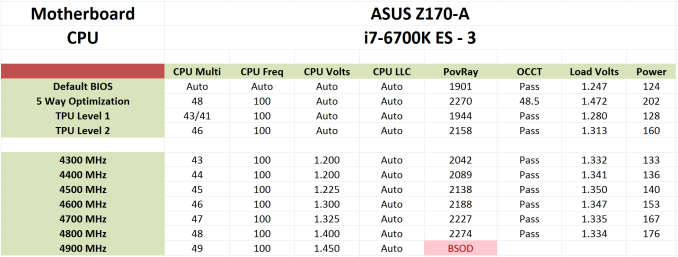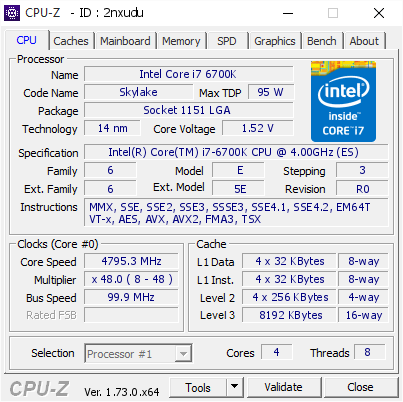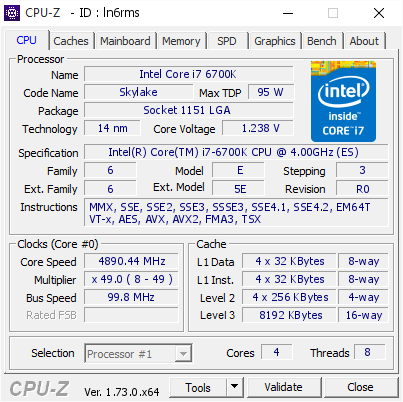The Intel Skylake i7-6700K Overclocking Performance Mini-Test to 4.8 GHz
by Ian Cutress on August 28, 2015 2:30 PM EST
At the time of our Skylake review of both the i7-6700K and the i5-6600K, due to the infancy of the platform and other constraints, we were unable to probe the performance uptake of the processors as they were overclocked. Our overclock testing showed that 4.6 GHz was a reasonable marker for our processors; however fast forward two weeks and that all seems to change as updates are released. With a new motherboard and the same liquid cooler, the same processor that performed 4.6 GHz gave 4.8 GHz with relative ease. In this mini-test, we tested our short-form CPU workload as well as integrated and discrete graphics at several frequencies to see where the real gains are.
In the Skylake review we stated that 4.6 GHz still represents a good target for overclockers to aim for, with 4.8 GHz being indicative of a better sample. Both ASUS and MSI have also stated similar prospects in their press guides that accompany our samples, although as with any launch there is some prospect that goes along with the evolution of understanding the platform over time.
In this mini-test (performed initially in haste pre-IDF, then extra testing after analysing the IGP data), I called on a pair of motherboards - ASUS's Z170-A and ASRock's Z170 Extreme7+ - to provide a four point scale in our benchmarks. Starting with the 4.2 GHz frequency of the i7-6700K processor, we tested this alongside every 200 MHz jump up to 4.8 GHz in both our shortened CPU testing suite as well as iGPU and GTX 980 gaming. Enough of the babble – time for fewer words and more results!


We actually got the CPU to 4.9 GHz, as shown on the right, but it was pretty unstable for even basic tasks.
(Voltage is read incorrectly on the right.)
OK, a few more words before results – all of these numbers can be found in our overclocking database Bench alongside the stock results and can be compared to other processors.
Test Setup
| Test Setup | |
| Processor | Intel Core i7-6700K (ES, Retail Stepping), 91W, $350 4 Cores, 8 Threads, 4.0 GHz (4.2 GHz Turbo) |
| Motherboards | ASUS Z170-A ASRock Z170 Extreme7+ |
| Cooling | Cooler Master Nepton 140XL |
| Power Supply | OCZ 1250W Gold ZX Series Corsair AX1200i Platinum PSU |
| Memory | Corsair DDR4-2133 C15 2x8 GB 1.2V or G.Skill Ripjaws 4 DDR4-2133 C15 2x8 GB 1.2V |
| Memory Settings | JEDEC @ 2133 |
| Video Cards | ASUS GTX 980 Strix 4GB ASUS R7 240 2GB |
| Hard Drive | Crucial MX200 1TB |
| Optical Drive | LG GH22NS50 |
| Case | Open Test Bed |
| Operating System | Windows 7 64-bit SP1 |
The dynamics of CPU Turbo modes, both Intel and AMD, can cause concern during environments with a variable threaded workload. There is also an added issue of the motherboard remaining consistent, depending on how the motherboard manufacturer wants to add in their own boosting technologies over the ones that Intel would prefer they used. In order to remain consistent, we implement an OS-level unique high performance mode on all the CPUs we test which should override any motherboard manufacturer performance mode.
Many thanks to...
We must thank the following companies for kindly providing hardware for our test bed:
Thank you to AMD for providing us with the R9 290X 4GB GPUs.
Thank you to ASUS for providing us with GTX 980 Strix GPUs and the R7 240 DDR3 GPU.
Thank you to ASRock and ASUS for providing us with some IO testing kit.
Thank you to Cooler Master for providing us with Nepton 140XL CLCs.
Thank you to Corsair for providing us with an AX1200i PSU.
Thank you to Crucial for providing us with MX200 SSDs.
Thank you to G.Skill and Corsair for providing us with memory.
Thank you to MSI for providing us with the GTX 770 Lightning GPUs.
Thank you to OCZ for providing us with PSUs.
Thank you to Rosewill for providing us with PSUs and RK-9100 keyboards.










103 Comments
View All Comments
Oxford Guy - Sunday, August 30, 2015 - link
Who is the one trolling?SanX - Saturday, August 29, 2015 - link
If Intel by moving to 14nm (with its potentially twice smaller surface area versus 22nm) made mainstream octacores overclockable like 4770k/4790k i'd be interested. Otherwise it is hard to see any progress at all. Shame, even cellphones are octacores.Oxford Guy - Sunday, August 30, 2015 - link
You can get AMD FX to run at over 4.5 GHz with generally only decent cooling. As for seeing progress, overclocking may be less and less viable as process nodes shrink.Oxford Guy - Sunday, August 30, 2015 - link
We seem to be seeing this borne out in the review, too. Voltages remain too high. Then, when that fails to do the trick, reviewers try to claim that unstable settings are good enough.stephenbrooks - Sunday, August 30, 2015 - link
I wonder how much of this is choice of the "optimum" frequency for the process? I think Intel only has two processes per node, a standard and a low-voltage/low-power one. If the standard one has been stretched to pretty low powers (10W?), the top end suffers from high voltages because it's not optimal there. They'd end up having to commission a 3rd "high frequency" process to get these top end chips right. There's no incentive until they have a real competitor there, but at this glacial rate of progress perhaps AMD really will catch up in a few years.SanX - Saturday, August 29, 2015 - link
Isn't true reason behind this zero progress that having no competition at all, Intel wants us to pay $3-4K for octacore chip which probably costs just $100-200 to produceMrSpadge - Thursday, September 3, 2015 - link
Of course they'd want us to pay 3-4k$ for an octacore, but they don't expect us to do so. That's why they sell it for 1k$.IUU - Sunday, August 30, 2015 - link
So, obviously it is not worth the benefit and the risk you take, to overclock it. Which is somewhat understandable. Overclocking it as a hobby is always nice, naturally.Of course, a progress would be to be able to overclock to 5.5Ghz, especially as 4.8 - 5.0 Ghz have been achieved already since several years. But you can't force nature.
On the other hand, I am just curious about the theoretical fp performace and the impact of the new instruction sets on it. The fact that the market chooses to ignore them, does not negate the potential of these processors.
And also curious as to how able they are to run narrow ai apps, or multitasking several "heavy" apps. Sorry, but the fixation on office, "professional apps", and first person shooter(or moving camera) games doesn't cut it anymore.
Would you be so interested to see how quickly your pc plays pacman in 2000? This is something like it.
I, myself have witbessed the effect of new instruction sets up to haswell, on niche apps. And I have to say , impressive is an understatement. We are talking a 40% percent improvement clock for clock. I just hope programmers will be in a position to take advantage of this untapped potential some day.
Also, algorithmic optimizations do perform miracles. I have seen them increasing the performance on the same app and chip up to 50%, instructions sets excluded.
And finishing, often seeing sites examining the performance of theses chips on browsers, is in my opinion, the peak of the decadence.(no matter how many useless addons we added or how much clunky we made, unneccesarily, the code.)
callous - Sunday, August 30, 2015 - link
I don't think most people test properly their overclocks. You always need to run prim95 with some 3d component looping for at least 24 hours. prime95 stable does not mean 3d stable. Only testing both at the same time: prime95 + 4 instances of heaven benmark can you test most of the components inside the cpu at the same time while system is being stressed.I would go further and say if you can do this for 24 hours then you should run some VMware and see if there are bad things happening like bsod or weird crashes of programs running the background.
sonny73n - Sunday, August 30, 2015 - link
I got excited when I first saw the title of this article but I'm a little disappointed now after finished reading it.1.52v for only 4.8Ghz? Does 14nm need that much voltage? My 32nm 2500k only needs 1.42v for 48x. What about temp under load? Regardless what settings Handbrake uses or 4K60fps it encodes, if it didn't cause BSOD with CPU at stock speed but BSOD when CPU OCed, then OC isn't stable. Since you OC this chip with the 2 best OCing mobo brands, then it's the chip's fault. Why did you use HB for stability test? P95 for 6 hours would do. Beside, IBT is about 8C hotter than P95 but HB runs about 10C cooler than P95. HB is hardly a stress test.
I might've missed it but did you have power saving features disabled or enabled? If you let the MB auto OC, what are the settings?